Many arborists & landscapers often find it difficult to prevent white pine weevil pests (Pissodes strobi), because they are typically applying fertilizer & dormant oil treatments during the control window. In NJ, the control window against feeding white pine weevil adults occurs in March & April. Adults overwinter in the duff beneath trees. The WPW adults will often crawl or sometimes fly to the top terminal leaders of pine, spruce, or Douglas-fir trees. Eastern white pine & Norway spruce species are the most severely attacked & the death of the terminal leaders of these trees will often occur.
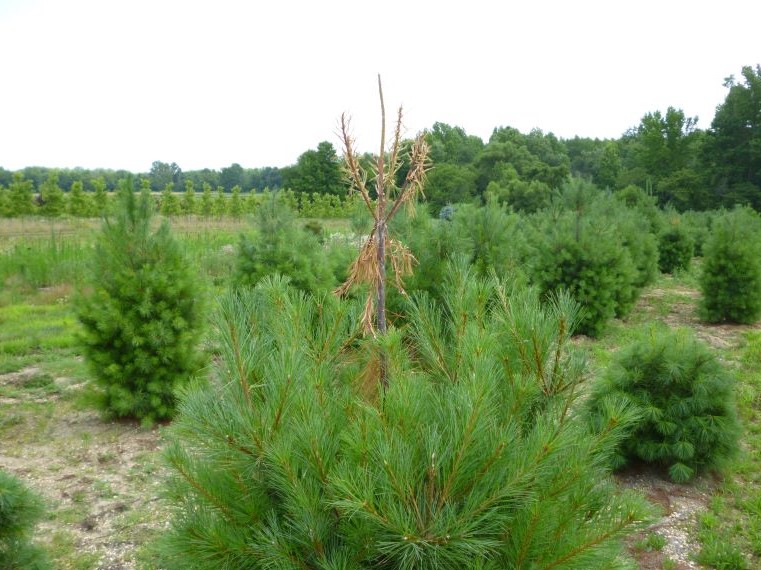
Often by July, an infested terminal will brown & die as the weevil larvae have destroyed the vascular tissues. (Photo Credit: Steven K. Rettke, Rutgers Coop. Ext.)
Treatment timing is critical with this pest, and controlling the adult female before egg laying is necessary. Apply preventative sprays (e.g., pyrethroids) only to the terminal leaders during this time. Before mating & egg laying, adults will feed by chewing holes within the central leader, causing a characteristic pitch flow that becomes white when dry. Then females will lay eggs in new cut-out holes within the top 12 inches of the leader just below the terminal bud.
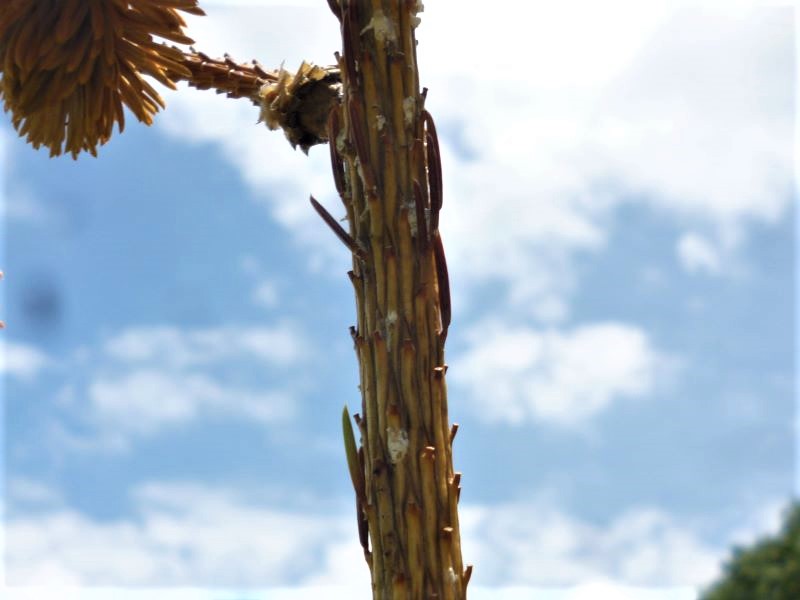
White pine weevil adults will feed within the upper terminal leaders & cause pitch flow that when dries has a white appearance. This is an early symptom that adults are active & control materials need to be applied. (Photo Credit: Steven K. Rettke, Rutgers Coop. Ext.)
Life-Cycle Overview:
Eggs:
The white pine weevil pest (Pissodes strobi) has only one larval generation per year. In NJ, overwintering adults can be active from mid-March into the late weeks of spring. After adults feed for a couple of weeks, oviposition can begin as early as the first week of April & can continue until early June. Eggs are laid in saucer-like cuts in last year’s leader within 12 inches below the terminal bud. Unlike feeding wounds, these cuts do not usually cause any pitch flow. Egg-hatching will occur 1 or 2 weeks later & with the extended egg-laying duration, can continue to hatch from mid-April into June. Females will lay an average of 100 eggs & it is not unusual for 2 or 3 mating pairs to infest a single leader.
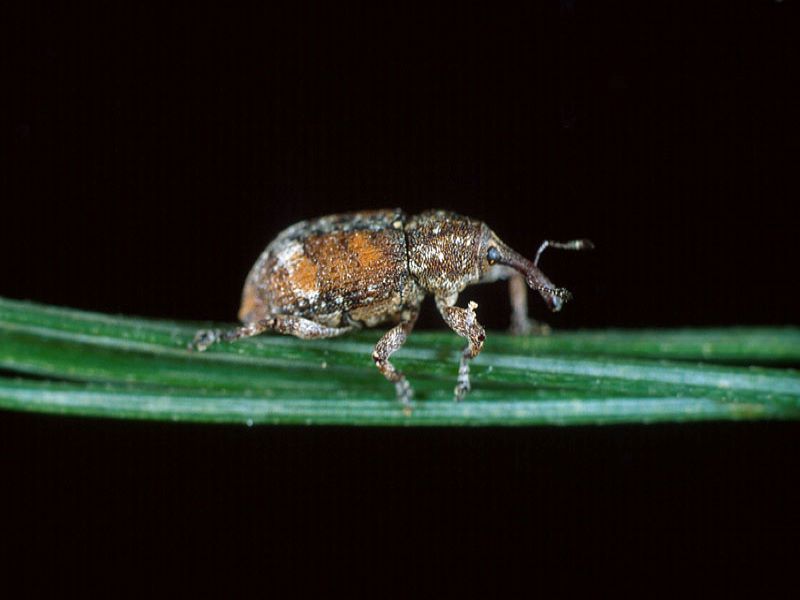
White pine weevil adults are about 1/4 to 2/5 inch long & have a long snout with two white spots on back of wing covers. Adults feed at terminal leaders during March & April. They will then lay eggs during April & inot May. (Photo Credit: Michigan State University)
Larvae:
When the terminal leader is heavily infested, potentially a few hundred larvae can initially compete for food in a single stem. As food becomes less available, many larvae will not survive to become adults. The larvae feed side by side in a ring encircling the stem. They tunnel downward as they burrow just under the bark, feeding within & destroying the vascular tissues. The larvae that survive will molt four times over a 5–6-week period before pupating & becoming adults. Late instar larvae can reach the size of 1/3 to 2/5 of an inch. In our region, depending on when they hatch, larvae could be active from mid-April to early August.
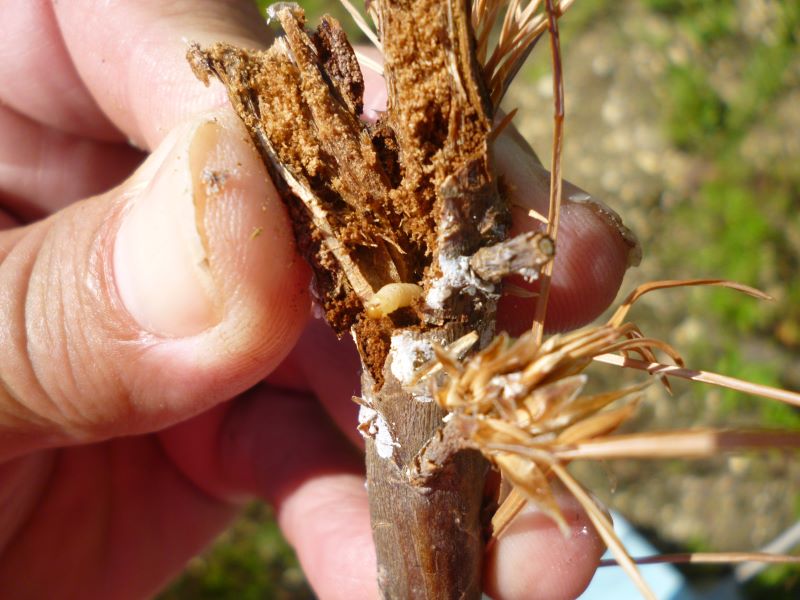
This late instar WPW has probably completed its 4th molt & has caused extreme damage within the vascular tissues of the terminal leader. (Photo Credit: Steven K. Rettke, Rutgers Coop. Ext.)
Symptoms:
The early feeding symptoms of the larvae will cause a “shepherd’s crook” in the new terminal growth. The young candle growth still extends during the spring, but by early summer, the feeding larvae will have destroyed much of the water-conducting tissues in the previous year’s leader. As the weeks of summer continue, the symptoms become more severe. The terminal leader will become stunted and wilted with the needles turning brown. Eventually, as a result, the new or current year’s leader & lateral growths will be killed without the larvae ever directly feeding within them. Sometimes larvae can tunnel past last year’s whorl of lateral branches & feed in the terminal leader from 2 years ago. Therefore, this could effectively result in 3 years of lost growth.
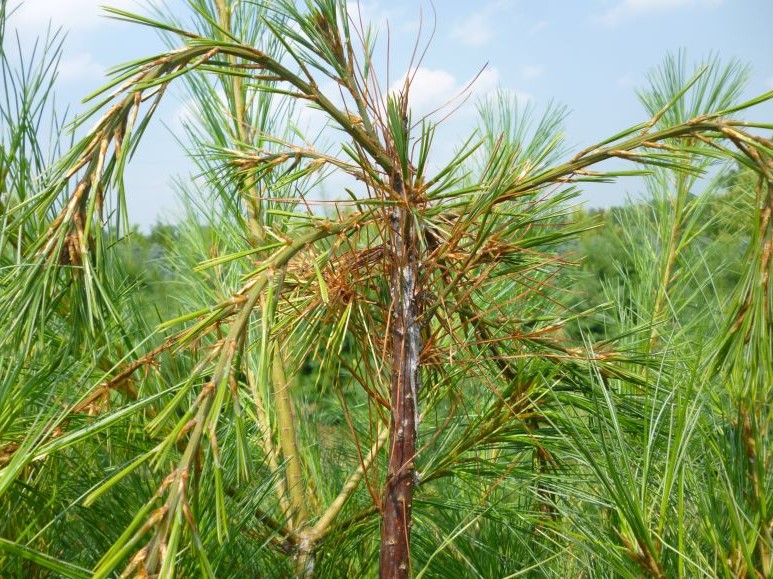
Adult white pine weevils initially feed within the terminal leader in early spring. Resin flow often results with feeding which turns white when dry. (Photo Credit: Steven K. Rettke, Rutgers Coop. Ext.)
Chemical Controls:
Chemical insecticides against white pine weevils during the spring period are only effective against the feeding adults & before females lay eggs. Aerial sprays only need to be applied to cover the terminal leaders at the tops of trees. Pyrethroids sprayed on the bark can have an effective residual of up to 3 weeks. Included within this group of insecticides are bifenthrin (e.g., Onyx), permethrin (e.g., Astro) & cyfluthrin (e.g., Tempo). Since an extended egg-laying duration occurs with this pest, a second application may be recommended.
When given enough time, a preventative systemic such as imidacloprid (e.g., Merit) can be applied as a soil injection or drench during the previous fall season (October or November) to control the early spring feeding period of adults. It can also be effective against the early instar larvae. This approach may only be economically viable when a few select trees can be targeted that have a history of this pest. (Neonicotinoids in NJ can only be applied within agricultural farm sites).

